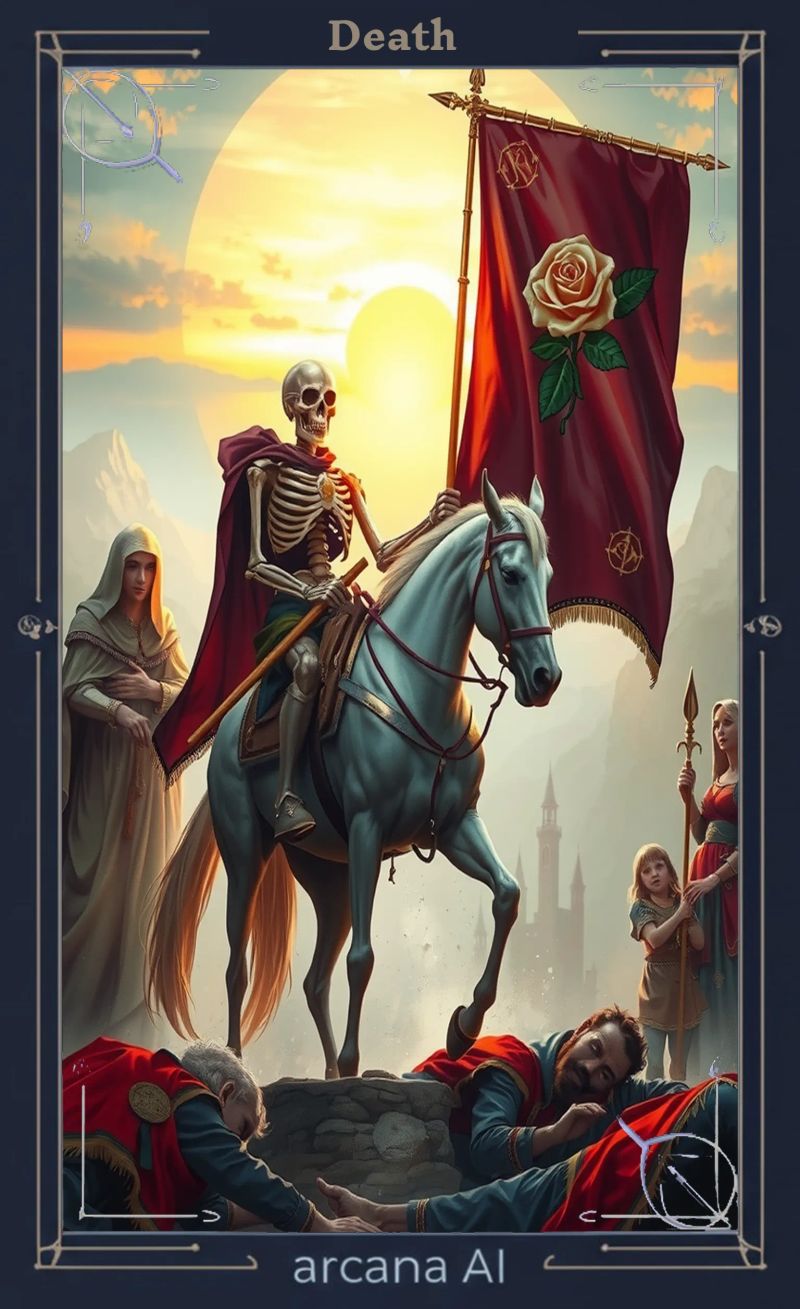Death (XIII)
Major Arcana - Card XIII
Death represents the profound spiritual principle of transformation, the inevitability of endings, and the promise of rebirth. This card embodies the understanding that all forms must eventually dissolve to make way for new growth, and that death is not an end but a necessary transition to renewal.
Upright Meaning
When Death appears upright in a reading, it signifies major transformation, the end of a significant phase or situation, and the beginning of something new. This card rarely indicates literal death, but rather the death of outdated patterns, relationships, or ways of being that no longer serve your growth.
Key Themes:
- Profound transformation and change
- Endings and closure
- Rebirth and renewal
- Release of what no longer serves
- Natural cycles of death and rebirth
Practical Applications: In career matters, Death suggests the end of a job, project, or professional identity, making way for new opportunities. In relationships, it may indicate the natural conclusion of a phase or the need to release toxic patterns. For personal growth, this card encourages embracing change and trusting in the process of transformation.
Reversed Meaning
When reversed, Death can indicate resistance to necessary change, stagnation, or delayed endings. You may be clinging to situations or relationships that have run their course, or experiencing repeated patterns that need to be released.
Key Themes:
- Resistance to necessary change
- Stagnation and lack of progress
- Fear of letting go
- Delayed endings or prolonged suffering
- Repeated negative patterns
Shadow Work: The reversed Death calls for examining where you may be resisting inevitable changes or clinging to outdated aspects of your life. It may indicate a need to confront fears of loss and embrace the transformative power of release.
Symbolism and Imagery
The Rider-Waite-Smith depiction of Death shows a skeletal figure in black armor riding a white horse through a field. The figure carries a black banner with a white rose, and people from all walks of life react differently to its presence - some pray, others resist, while one child appears accepting.
Death as Skeleton: The skeletal figure represents the stripping away of flesh (ego, material concerns) to reveal the essential truth. The armor suggests that Death is an inevitable force that cannot be resisted by material means. The figure’s crown indicates that Death is the king of transformation.
The White Horse: The pale horse symbolizes purity and the vehicle of transformation. In the Book of Revelation, the pale horse carries Death as one of the Four Horsemen of the Apocalypse, emphasizing the inevitability and impartiality of change.
The Black Banner with White Rose: The black banner represents mourning and endings, while the white rose symbolizes purity, rebirth, and the promise of new beginnings. This combination suggests that within every ending lies the seed of renewal.
The Colors:
- Black armor: Mystery, the unknown, and the finality of endings
- White horse: Purity, spiritual transformation, and divine will
- Red feather: Vitality, passion, and the life force in transition
- Gray field: Neutrality and the liminal space between states
Symbolic Elements:
- Praying figures: Acceptance and surrender to divine will
- Resisting figures: Fear and denial of inevitable change
- Accepting child: Innocence and natural understanding of life’s cycles
Historical Context
Death has been one of the most feared and misunderstood cards in tarot, largely due to its name and imagery. However, in esoteric traditions, this card represents the necessary process of alchemical transformation - the death of the old self to allow the birth of the new.
The Rider-Waite-Smith version draws from multiple sources: the Book of Revelation’s pale horseman, medieval Dance of Death imagery, and alchemical symbolism of putrefaction and rebirth. The card embodies the spiritual truth that transformation requires the dissolution of existing forms.
Card Combinations and Interactions
With The Tower: Amplifies themes of sudden, dramatic change and the need to rebuild from fundamental levels.
With The Hanged Man: Suggests that voluntary surrender and acceptance can ease the process of transformation.
With The Fool: Indicates that new beginnings often require letting go of past patterns and embracing uncertainty.
With Temperance: Creates a combination emphasizing alchemical transformation and the middle path through change.
With The Empress: Suggests that creative renewal and growth emerge from periods of transformation and release.
Astrological and Elemental Correspondences
Astrological Sign: Scorpio - The sign of death, rebirth, and transformation. Scorpio’s association with Death emphasizes deep psychological change, regeneration, and the uncovering of hidden truths.
Element: Water - Representing emotions, intuition, and the flow of consciousness. The water element in Death is deep and still, like the primordial waters from which all life emerges and to which all forms return.
Planet: Pluto - The planet of transformation, death, and rebirth. Pluto’s influence suggests profound, irreversible change that operates beneath the surface of conscious awareness.
Hebrew Letter: Nun (נ) - Meaning “fish,” representing the life within death, the spark of consciousness that survives transformation, and the continuation of the soul’s journey through cycles of change.
Explore More
Discover deeper insights about this card by using the Arcana AI app for personalized tarot readings tailored to your specific situation and question.
